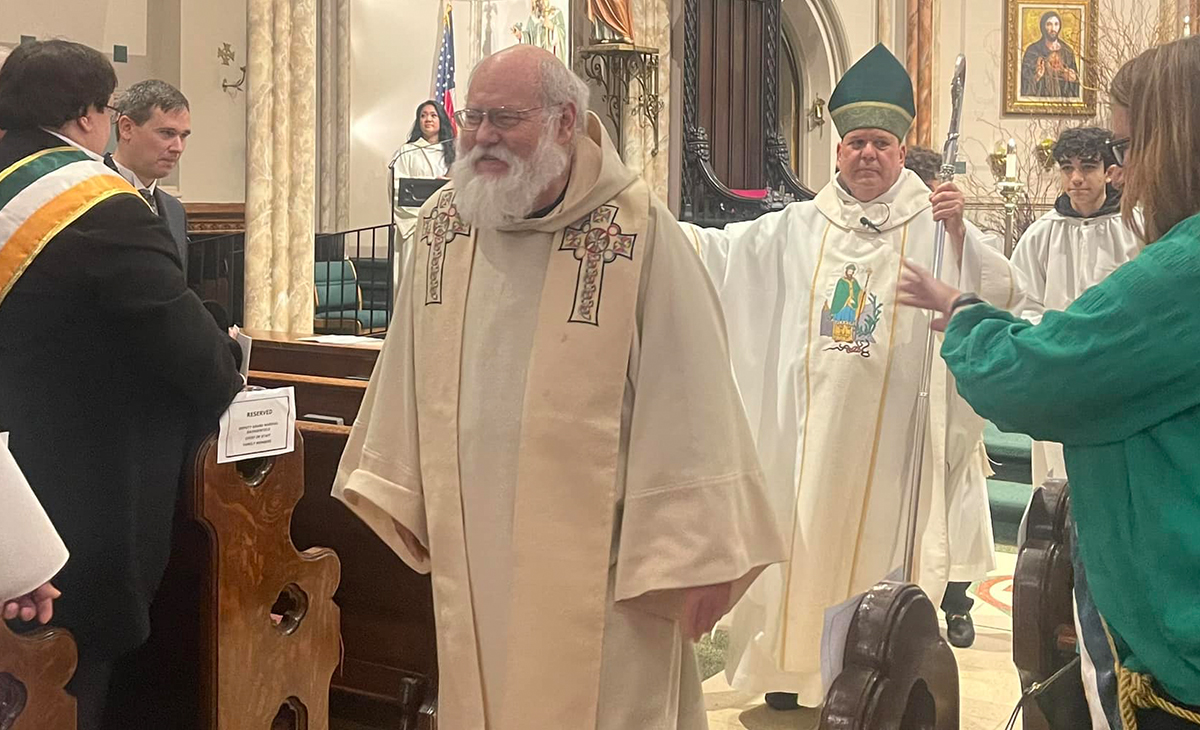Churches around the Archdiocese of Newark celebrate spring feast days
Springtime in the Archdiocese of Newark brings a variety of celebrations to local churches before the popular summer feasts. These devotions range from globally recognized feasts like St. Joseph and St. Patrick to more culturally specific celebrations.
Scroll below to see how our churches have been commemorating their faith this spring.
Saint Blaise – Feb. 3
Saint Blaise is a bishop of the early Church, known for encouraging the spiritual and physical health of his people in Armenia. According to a legend, a mother came to him with her young son who had a fish bone lodged in his throat, and at the saint’s command, the child coughed up the bone. In 316, he was beheaded for not sacrificing to pagan gods.
On his feast day, Catholics receive the Blessing of the Throats, in which a priest, deacon, or lay minister crosses two candles over the recipient’s throat and recites the blessing: “Through the intercession of St. Blaise, bishop and martyr, may God deliver you from every disease of the throat and from every other illness, in the name of the Father and of the Son and of the Holy Spirit.”



Our Lady of Lourdes – Feb. 11
This feast of Our Lady of Lourdes recognizes the 18 Marian apparitions to 14-year-old Bernadette Soubirous in Lourdes, France in 1858. The grotto where she saw the apparitions of Mary is now the second-most visited Christian pilgrimage site in Europe, receiving more than five million pilgrims each year.
According to the apparitions experienced by Bernadette, Our Lady instructed her to excavate the nearby ground, which led to the emergence of a spring possessing healing properties that is still active today. Since then, a vast number of pilgrims have traveled to Lourdes in search of healing from this spring.


Saint Casimir – March 4
Saint Casimir Jagiellon was a 15th-century prince whose life of service to God has made him a patron saint of Poland, Lithuania, and young people.
Saint Casimir was the third of 13 children born to Poland’s King Casimir IV. The young prince had a distaste for the luxury of courtly life and instead chose the way of asceticism and devotion — wearing plain clothing, sleeping on the floor, and spending his nights in prayer. He became known for his piety, devotion to God, and generosity towards the sick and poor.
He died at the age of 25 from tuberculosis.


Saint Patrick – March 17
Saint Patrick is a 5th-century bishop and patron of Ireland. He was captured by Irish raiders when he was about 16 and taken as a slave to Ireland where he lived for six years as a shepherd before escaping and returning to his home in Britain.
Upon returning, he studied the Christian faith in Italy and France and was ordained a deacon, and then a bishop. Saint Patrick was assigned to minister to the small, Christian communities in Ireland who lacked a central authority and were isolated. He was able to use his knowledge of Irish culture that he gained during his years of captivity to explain Christianity in a way that made sense to the Irish and was very successful in converting the natives.
The shamrock, which Saint Patrick used to explain the Holy Trinity, is a symbol that has become synonymous with Irish Catholic culture.








Saint Joseph – March 19
The Solemnity of Saint Joseph, Spouse of the Blessed Virgin Mary, is among the most prominent feast days in the Catholic Church and holds particular reverence in Italian Catholic communities worldwide.
Historically, Saint Joseph’s Day was widely celebrated by Italians of the Archdiocese of Newark in the early to the mid-20th century. As legend has it, during a great famine and drought in Sicily in the Middle Ages, people prayed to Saint Joseph for relief. Their prayers were answered with rains that spared their crops, and it’s believed that this is why Saint Joseph’s celebration is held in March each year. When the rain came, the people prepared tables of food in thanksgiving which became the annual celebration known at Saint Joseph’s Altars.
















Divine Mercy – April 16
Divine Mercy Sunday, or the Feast of the Divine Mercy, is celebrated on the Second Sunday of Easter.
It was established in 2000 by Saint John Paul II during the canonization of Saint Maria Faustina Kowalska, a 20th-century Polish mystic. As a Sister of Our Lady of Mercy, the unassuming saint shared how she enjoyed numerous visions in which Christ urged her to promote devotion to his mercy through various prayers, an annual feast, and an image featuring rays of blood and water issuing from his heart.
The devotion to Divine Mercy Sunday grew rapidly after its designation by Pope John Paul II and is now widely celebrated by Catholics



Most Holy Mary Crowned (Maria Santissima Incoronata di Foggia) – April 29
The origin dates to the year 1001, near Foggia, Italy, when the Count of Ariano Irpino was on a hunting trip and came upon a deer kneeling at a tree. The tree became luminous and Mary appeared, requesting that a shrine be built on that spot, and that it not be adorned with gold or precious ornaments, but designed for the poor.
A small chapel was built and it became a place of pilgrimage, even for saints like Saint Francis of Assisi, Saint Thomas Aquinas, Saint. Anthony of Padua and, more recently, Pope John Paul II. The original chapel was replaced by the current Sanctuary of Mary Mother of God Crowned, constructed in 1950.
At the turn of the 20th century, Italian immigrants from Alberona (a town of Foggia) brought the devotion to Orange. The feast is celebrated on the last Saturday of April every year.



To see how Holy Week was celebrated around the Archdiocese of Newark, click here.


